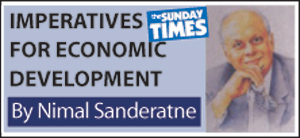Columns
Achieving a trade surplus in 2020: A challenging task
View(s):An important objective of the Government is to achieve a trade surplus by 2020. This key objective, according to Treasury Secretary P.B. Jayasundera, is to be achieved through two strategies: Import substitution and increased exports. This is a challenging task given the trade deficits of more than US$ 7 billion in recent years and exports being only about 45 per cent of the value of imports. However, aiming for a trade surplus is a laudable objective that must be backed up by policies that curtail unproductive expenditure and support export expansion.
 Persistent trade deficits
Persistent trade deficits
Barring a few years, the country has had persistent trade deficits since 1950. The last trade surplus was recorded in 1977. It was a mere US$ 41 million (about Rs. 200 million at that time). Even this small surplus was achieved by severe import and exchange controls.
The periods when import substitution policies were pursued provide ample evidence of their failure to improve the trade balance, besides heaping severe hardships on the population. The structure of the country’s imports and exports, the restricted resource base and small domestic market make it difficult to contract the trade deficit through import substitution. It is only through successful export performance that the country can achieve a trade surplus.
Import-export structure
Although the import-export structure of the country has changed since the 1980s, the trade balance is vulnerable. The economic transformation since the 1980s has resulted in a high dependence on raw materials — or intermediate imports – and capital imports. Consequently international prices of intermediate imports are a determining factor in the trade balance. Prices of oil, fertilizer and other raw material are of considerable significance to the trade balance. The capacity for import substitution in these is limited.
 Reducing imports
Reducing imports
There are some limited possibilities of improving the trade balance by decreasing intermediate imports that account for more than 50 per cent of import expenditure. But there are limits. This is because the main intermediate imports such as oil, fertilizer, textiles and chemicals are essential for the economy. Oil imports that constitute more than 25 per cent of total import expenditure are difficult to be slashed. However, the new coal power plants and good rainfall could help to a certain degree. A more enlightened transport policy that increases public transportation and reduces private motor vehicles is another means by which oil consumption could be reduced.
The salient issue is by how much could oil imports be reduced? Oil imports are used for thermal generation of electricity, industrial production, public and private transport. However, these consumption needs are more or less essential and would be difficult to curb to any significant extent.
The curtailment of expenditure on petrol is also made difficult owing to the Government`s failure to reduce its consumption of fuel. Despite these limitations, measures to conserve electricity and petroleum products would be necessary to achieve a significant curtailment of oil imports. Reducing oil imports is vital as the oil market is unstable. It’s only by the reduction of oil imports that expenditure on imports could be contained at least around the current expenditure.
The import of textiles that are needed mostly for garment exports and other raw materials that are needed for the manufacture of exports account for about 15-17 per cent of import expenditure and can hardly be reduced. Given the high import content of exports, and the high propensity to import due to increasing incomes, imports would increase over time.
Investment goods
Investment goods imports have also strained the balance of payments. Investment goods imports increased significantly in recent years. Capital imports such as machinery, transport equipment and building materials have accounted for about 20 per cent of import expenditure in recent years. This expenditure is justified on the grounds that it contributes to economic growth. However all investment goods imports are not necessarily for development and the returns on such investment could be low and slow. Given the current and foreseeable balance of payments difficulties due to high capital imports, there has to be a rethinking on the nature and extent of capital expenditure. Capital expenditure that has high import content and does not increase exports or has a long gestation period would require to be curtailed.
Import substitution
Discussions of import substitution are often based on possibilities of import substitution in food. Food imports are only about 11 per cent of total imports and about one half of this are of foods that are not produced in Sri Lanka such as wheat and dhal. There are also limits of land and water that constrain food production. Increased production of food by improved productivity is essential to feed the increasing population and constrain higher imports in the future. However, this must be achieved through efficient production.
Increasing exports
The constraints in decreasing imports point strongly to a need to increase exports substantially. The country’s export performance has been disappointing. Exports as a proportion of total world exports as well as a proportion of the country’s Gross Domestic Product (GDP) have declined. Exports as a share of GDP declined from about a third of GDP in 2000 to about half that at present. This is highly unfavourable to the trade balance and balance of payments. Although Sri Lanka’s exports have increased over the years in absolute terms, imports have been rising much faster and there have been huge trade deficits in recent years of US$ 7-9.7 billion.
Increasing exports
A trade surplus by 2020 is possible only by significant increases in exports. This could be achieved only by improving the investment climate, better investment in education, science education and skills development and incentives for exports. Attracting foreign direct investment to establish hi-tech industries to expand exports and transfer technology, management skills and marketing capacities are vital to achieve higher exports.
The objective of achieving a trade surplus by 2020 can be achieved only by putting in place the appropriate macroeconomic policies, ensuring law and order, the rule of law and property rights. Improvements in education and reforms in labour legislation and liberalised trade policies are no less important.

